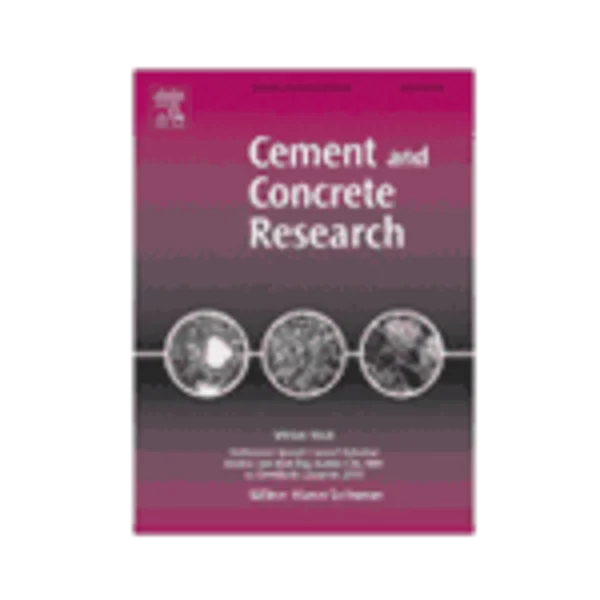-
influence of mineralogy on the hydraulic properties of ladle slag
جزئیات بیشتر مقاله- تاریخ ارائه: 1392/07/24
- تاریخ انتشار در تی پی بین: 1392/07/24
- تعداد بازدید: 933
- تعداد پرسش و پاسخ ها: 0
- شماره تماس دبیرخانه رویداد: -
the present study is aimed at investigating the hydraulic characteristics of ladle furnace slag (lfs), under the pretence of using lfs as a cement substitute in certain applications. furthermore, lfs has been considered as a possible activator in a blend containing 50% lfs, and 50% ground granulated blast furnace slag (ggbfs). phases detected in lfs were quantified using rietveld analysis. calorimetric studies were performed at 20, 25 and 30 °c in order to calculate the apparent activation energy of hydration and thereby to suggest a kinetic model for the tested compositions within this temperature interval. in addition, compressive strength tests were performed on mortar prisms made with lfs, and lfs/ggbfs which had hydrated for 2, 7 and 28 days. both compositions reached acceptable early strengths, (e.g. lfs, 33.1 mpa, and lfs/ggbfs, 17.9 mpa, after 2 days), but after 28 days hydration the blend was superior to neat lfs. related apparent activation energies were determined using an avrami–erofeev model and gave ea = 58 kj/mol for neat lfs and ea = 63 kj/mol for the blend. the results imply that lfs or a lfs/ggbfs blend can be favourably used as supplement in binder applications such as binder in by-product metallurgical briquettes, which are used as recycle to the blast furnace or basic oxygen furnace depending on the specific briquette composition.
مقالات جدیدترین رویدادها
-
استفاده از تحلیل اهمیت-عملکرد در ارائه الگوی مدیریت خلاقیت سازمانی و ارائه راهکار جهت بهبود
-
بررسی تاثیر ارزش وجوه نقد مازاد بر ساختار سرمایه شرکت های پذیرفته شده در بورس اوراق بهادار تهران
-
بررسی تأثیر سطح افشای ریسک بر قرارداد بدهی شرکت های پذیرفته شده در بورس اوراق بهادار تهران
-
بررسی تأثیر رتبه بندی اعتباری مبتنی بر مدل امتیاز بازار نوظهور بر نقد شوندگی سهام با تأکید بر خصوصی سازی شرکت ها
-
تأثیر آمیخته بازاریابی پوشاک ایرانی بر تصویر ذهنی مشتری پوشاک ایرانی (هاکوپیان)
-
بادگیر (بادخان و بادخور) عناصر کاربردی در سرمایش و تهویه ساختمان های مدرن با استفاده از انرژی های تجدیدپذیر
-
بررسی اثر بخشی آموزش هوش هیجانی بر کاهش پرخاشگری و افزایش سازگاری فردی، اجتماعی دانش آموزان پسر پایه ششم
-
مهندسی مجدد فرآیند حسابداری اطلاعات بر مبنای erp
-
a miniature generator using piezoelectric bender with elastic base
-
pseudo-static seismic analysis of retaining walls with circular failure wedge in frictional-cohesive backfill through horizontal slices method
مقالات جدیدترین ژورنال ها
-
مدیریت و بررسی افسردگی دانش آموزان دختر مقطع متوسطه دوم در دروان کرونا در شهرستان دزفول
-
مدیریت و بررسی خرد سیاسی در اندیشه ی فردوسی در ادب ایران
-
واکاوی و مدیریت توصیفی قلمدان(جاکلیدی)ضریح در موزه آستان قدس رضوی
-
بررسی تاثیر خلاقیت، دانش و انگیزه کارکنان بر پیشنهادات نوآورانه کارکنان ( مورد مطالعه: هتل های 3 و 4 ستاره استان کرمان)
-
بررسی تاثیر کیفیت سیستم های اطلاعاتی بر تصمیم گیری موفق در شرکتهای تولیدی استان اصفهان (مورد مطالعه: مدیران شرکتهای تولیدی استان اصفهان)
-
بررسی اطلاعات متقارن در پیش بینی های تحلیل گران سهام از عملکرد شرکتی و رفتار سرمایه گذاران
-
رابطه بین حق الزحمه حسابرسی و تجربه حسابرس با کیفیت حسابرسی
-
ﺗﺒﯿﯿﻦ مدلهای ﺟﺎﯾﮕﺰﯾﻦ قیمت گذاری دارایی در پیش بینی بازده مورد انتظارسهام
-
ارزیابی نحوه اجرای اصل عدم تبعیض در خصوص حقوق پناهندگان
-
investigate the effect of services compensation system on employee performance in forensic of kohgiluyeh and boyerahmad province




سوال خود را در مورد این مقاله مطرح نمایید :